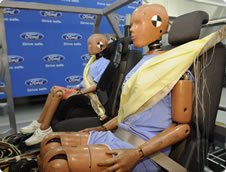-
MATERIAL ISSUES
- Materiality Analysis
- Climate Change
- Mobility
- Human Rights
-
Vehicle Safety
- Challenges and Opportunities
- How We Manage Vehicle Safety
- Encouraging Safer Driving
-
Building Ever-Safer Vehicles
- Accident Avoidance Technologies
- Occupant Protection Technologies
- Post-Crash/Injury Mitigation Technologies
- Research
- Promoting Safer Roadways
- Collaborative Efforts
- Data
- Case Study: Driver Distraction
- Sustaining Ford
- Perspectives on Sustainability
Toolbox
Occupant Protection Technologies
Many factors influence a vehicle's crashworthiness, including the design of the vehicle's structure to absorb impact energy and the use of passive safety equipment such as air bags. To help protect drivers and passengers in the event of a crash, a variety of Ford technologies have been designed to enhance the performance of safety belts and air bags and provide additional occupant protection in side crashes and rollovers.

Ford introduces the auto industry's first-ever production inflatable seat belts, which are designed to provide additional protection for rear-seat occupants.
Safety belts remain the most important vehicle safety technology available. In 2010, Ford is bringing to market the world's first automotive inflatable seat belts, combining the attributes of traditional seat belt and airbag technologies to help reduce head, neck and chest injuries for rear-seat passengers. Ford will introduce inflatable rear seat belts on the next-generation Ford Explorer, to be introduced in 2010 in North America. Over time, Ford plans to offer the technology in vehicles globally.
The inflatable belts are designed to deploy over a vehicle occupant's torso and shoulder in 40 milliseconds in the event of a crash. Each belt's tubular airbag inflates with cold compressed gas. The inflatable belt's increased diameter can more effectively restrain the occupant in the appropriate seating position in the event of a frontal or side crash, and the belt distributes crash force energy across five times more of the occupant's torso than a traditional belt, helping to further reduce the risk of injury.
In everyday use, the inflatable belts operate like conventional seat belts and are safe and compatible with infant and child safety car and booster seats. In Ford's research, more than 90 percent of those who tested the inflatable seat belts found them to be similar to or more comfortable than a conventional belt because they feel padded and softer. That comfort factor could help improve the 61 percent rear-belt usage rate in the U.S., which compares to 82 percent usage by front-seat passengers, according to NHTSA. Ford will monitor real-world effectiveness and customer acceptance of this new technology as it begins the phase-in into the Ford fleet.
Ford was the first in the industry to offer rollover-activated side-curtain air bags, known as the Safety Canopy®, beginning with the Ford Explorer and Mercury Mountaineer in 2002. Today, the Safety Canopy with rollover sensors – which helps reduce the risk of injury to vehicle occupants during side-impact collisions and rollover accidents – is available on most Ford vehicles, including the Ford Taurus, Flex, Edge, Escape, Explorer, SportTrac, Expedition and F-Series; the Mercury Mariner and Mountaineer; and the Lincoln MKS, MKX, MKT and Navigator. By the 2010 model year, all Ford, Lincoln and Mercury retail SUVs and crossovers, as well as vans and trucks under 8,500 lbs., are planned to have the Safety Canopy as standard equipment.
The 2010 Ford Taurus, Ford Flex, Lincoln MKS and Lincoln MKT have been engineered with crush zones designed to direct excess energy around the passenger compartment into a high-strength frame. This advanced engineering design – known as SPACE™ Architecture – utilizes crash form management techniques to help channel impact forces around and away from the passenger cabin.
In Europe, the Ford Mondeo, S-MAX and Galaxy are equipped with an Inflatable Knee Bolster, designed to help reduce the driver's forward motion in the event of a severe frontal crash and reduce the risk of injury to lower limbs. This technology is also available on the 2010 Fusion Hybrid and Milan Hybrid and on the 2011 Ford Fiesta in the United States.
Finally, as smaller and more fuel-efficient vehicles become more popular, the safety of smaller cars is sometimes raised as a concern. Ford's study of accident trends found that fatality rates for small cars of the 1990s were lower than for large cars of the 1970s, due to improvements in vehicle safety, changing driver behavior such as increased seat-belt usage and generally safer road infrastructure.
Ford's focus is to continue making small cars even safer while building larger vehicles that are more crash compatible with smaller vehicles. We've already lowered the front bumper structures on most of our crossovers, SUVs and pickups to help them better match up with small vehicle crash structures. Ford now uses more high-strength steel as part of our continuing effort to enhance the safety and fuel efficiency of our vehicles. In fact, we have recently introduced ultra-high-strength steel as well. Increased usage of high-strength steels helps us design vehicle structures with enhanced crash energy management, while balancing overall vehicle weight – even as we add more standard safety equipment.